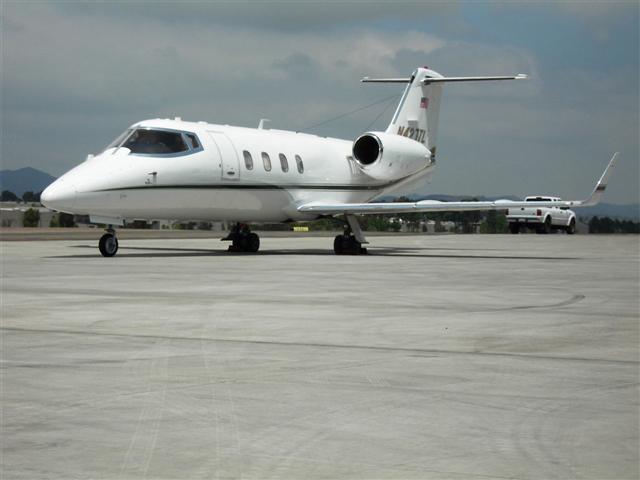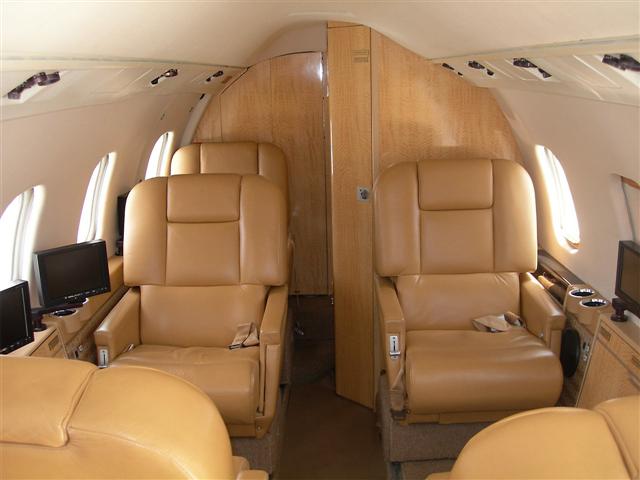


Aircraft Description
Background/History
The Learjet 55 is one of the more highly refined developments in the long line of aircraft descended from Bill Lear’s original Lear 23, which made its first flight in October 1963. While all of the 20-series Learjets were powered by turbojet engines, the current generation of turbofan-powered Learjets began in July 1974 with the certification of the Learjet 35. In 1979 the turbojet-powered 20-series Learjets included the 28 & 29 Longhorn models with their increased-span wings and winglets. The Learjet 55 represented a combination of the Longhorn wing with the TFE731 turbofan engines of the 30-series, and a new, larger fuselage. The prototype of the 55 accomplished its first flight in April 1979, and received FAA certification in March 1981and continued in production through 1985 with a production run of 125 aircraft. Later variants include the model 55B, which introduced the digital cockpit to the Learjet family, and the 55C, whose lower tail-section “Delta fins” improved handling and have appeared on all succeeding Learjet models. The 55-series was replaced by the Learjet 60 in 1992.
Power
The Learjet 55 is powered by a pair of Honeywell TFE 731-3A-2B turbofans rated at 3,700 lbs. of thrust each. Inspection interval on the engines is 4,200 hours.
Avionics
A typical avionics package on a Lear 55 might consist of Dual Collins VHF20A comms, Dual VIR30A navs, Global FMS GNS/XLS, King 90A GPS, Dual Collins TDR90 transponders, Collins ADF 60, DME40, Collins color weather radar and TCAS.
Design Features
The Learjet 55 is a medium-range, twin turbofan-powered business aircraft configured as a cantilever low-wing monoplane with slight leading-edge sweep. The swept horizontal and vertical stabilizers are arranged in a T-tail configuration. Its retractable tricycle landing gear has dual wheels on each of the main units and a single wheel on the nose gear. The wing, with its drag-reducing winglets, is adapted from the earlier “Longhorn” series Learjets, while the fuselage of the 55 series was a new design, the largest yet used on a Learjet model.
Accomodations
The cabin of the Learjet 55 is normally optimized for a seven- or eight-passenger arrangement, but can accomodate ten in a high-density configuration. The new fuselage introduced with the 55-series provides 50% more cabin volume than was available in the earlier 30-series Learjets. Typical cabin layout has a club arrangement with one additional seat aft adjacent to the half-width lavatory and a two-place side-facing bench seat forward, opposite the small galley/refreshment center. Two class “D” external baggage compartments are available-one in the nose and one in the aft fuselage. Additional baggage storage is available inside the cabin, aft of the lavatory. Cabin height is 5.7ft., cabin width is 5.9ft., and cabin length is 13.7ft.
| General | Learjet 55, LR-55 | |||
|---|---|---|---|---|
| Category | Jet < 20,000 lbs. | |||
| Years Aircraft Manufactured | 1981 – 1986 | |||
| Serial Number Range | 001 – 126 | |||
| Retail High Price | $2,100,000.00 / 1,647,870.00€ | |||
| Retail Low Price | $795,000.00 / 623,836.50€ | |||
| Characteristics | Learjet 55, LR-55 | |||
| Seating | 2 + 7/10 | |||
| Wing Loading | 81.3 | |||
| Power Loading | 2.9 | |||
| Noise(EPNdB): Takeoff/Sideline/Approach | 86.3/91.0 | |||
| External Dimensions (ft) | Learjet 55, LR-55 | |||
| External Length | 55.1 | |||
| External Height | 14.7 | |||
| External Span | 43.8 | |||
| Internal Dimensions (ft) | Learjet 55, LR-55 | |||
| Internal Length (Overall/Net Height) | 13.7 | |||
| Internal Height | 5.7 | |||
| Internal Width (Max/Floor) | 5.9 | |||
| Baggage | Learjet 55, LR-55 | |||
| External: Cu.Ft./Lb. | N/A | |||
| External: Cu.Ft./Lb. | N/A | |||
| Power | Learjet 55, LR-55 | |||
| Engines | 2 Hon TFE731-3A-2B | |||
| Output (lbs ea.)/Flat Rating | 3,700 | |||
| Inspection Interval | 4,200c | |||
| Data based on latest manufactured year | ||||



